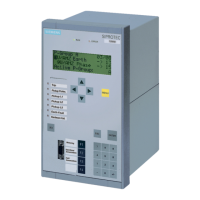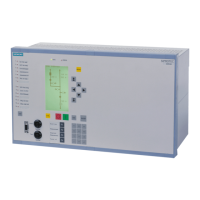[synchronkontr-trafo-wlk-310702, 1, en_GB]
Figure 2-21 Synchronism check across a transformer - example
The synchronism check function in the 7VK61 usually operates in conjunction with the integrated automatic
reclose, manual close, and the control functions of the relay. It is also possible to employ an external auto-
matic reclosing system. In such a case signal exchange between the devices is accomplished via binary inputs
and outputs (see Figure 2-22).
When closing via the integrated control function, the configured interlocking conditions may have to be veri-
fied before checking the conditions for synchronism. After the synchronism check grants the release, the inter-
locking conditions are not checked a second time.
Furthermore, switching is possible under synchronous or asynchronous system conditions or both.
Synchronous switching means that the closing command is issued as soon as the following critical values lie
within the set tolerances:
•
Voltage magnitude difference AR maxVolt.Diff (address 3511) or MC maxVolt.Diff (address
3531)
•
Angle difference AR maxAngleDiff (address 3513) or MC maxAngleDiff (Adresse 3533)
•
Frequency difference AR maxFreq.Diff (address 3512) or MC maxFreq.Diff (address 3532)
For switching under asynchronous system conditions, the device determines the time for issuing the ON
command from the current angle and frequency difference such that the angle difference of the voltages
(between busbar and feeder) is almost 0° at the instant the poles make contact. For this purpose, the device
requires the parameter (address 239 T-CB close) with the set circuit breaker closing time. Different
frequency limit thresholds apply to switching under synchronous and asynchronous conditions. If closing is
permitted exclusively under synchronous system conditions, the frequency difference limit for this condition
can be set. If closing is permitted under synchronous as well as under asynchronous system conditions, a
frequency difference below 0.01 Hz is treated as a synchronous condition, a higher frequency difference value
can then be set for closing under asynchronous system conditions.
The synchro check function only operates when it is requested to do so. Various possibilities exist for this
purpose:
•
Measuring request from the internal automatic reclosure device. If the internal automatic reclosing func-
tion is set accordingly (one or more reclosing attempts set to synchronism check, see also Section
2.2.2 Setting Notes), the measuring request is accomplished internally. The release conditions for auto-
matic reclosing apply (parameter AR...).
•
Request to execute a check synchronism measurement from an external automatic reclosure device. The
measuring request must be activated via the binary input
>Sync. Start AR
(No. 2906). The release
conditions for automatic reclosing apply (parameter AR...).
•
Measuring request from the manual CLOSE detection. The manual CLOSE detection of the central func-
tion control (Section 2.8.1 Function Control) issues a measuring request provided that this was config-
ured in the power system data 2 (address 1151). This requires that the device is informed of the manual
closing via binary input
>Manual Close
(No. 356). The release conditions for manual closure apply
(parameter MC...).
Functions
2.4 Synchronism and voltage check (optional)
84 SIPROTEC 4, 7VK61, Manual
C53000-G1176-C159-5, Edition 05.2018

